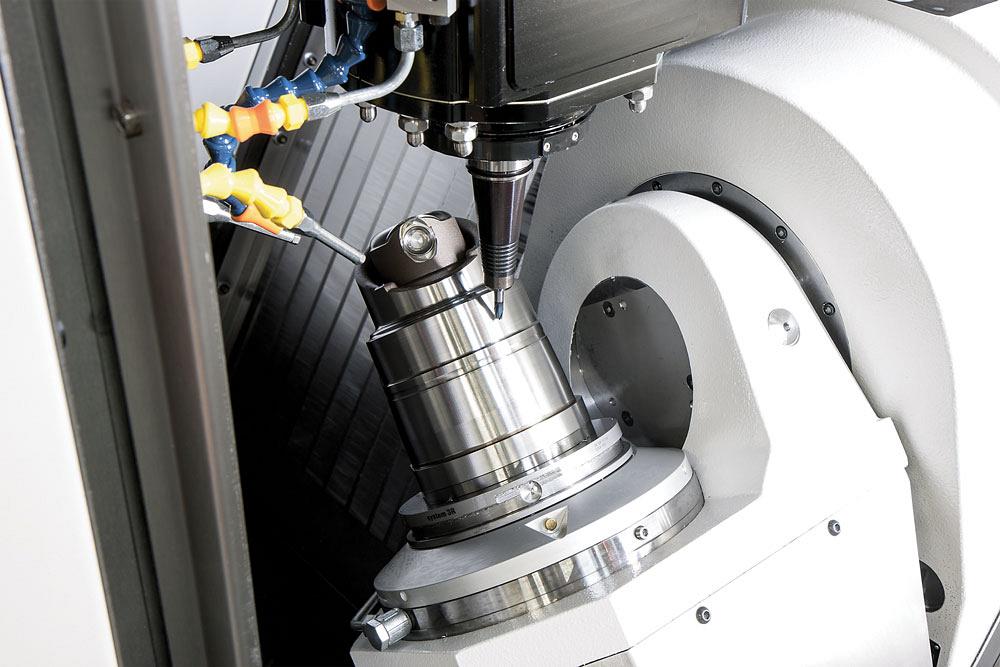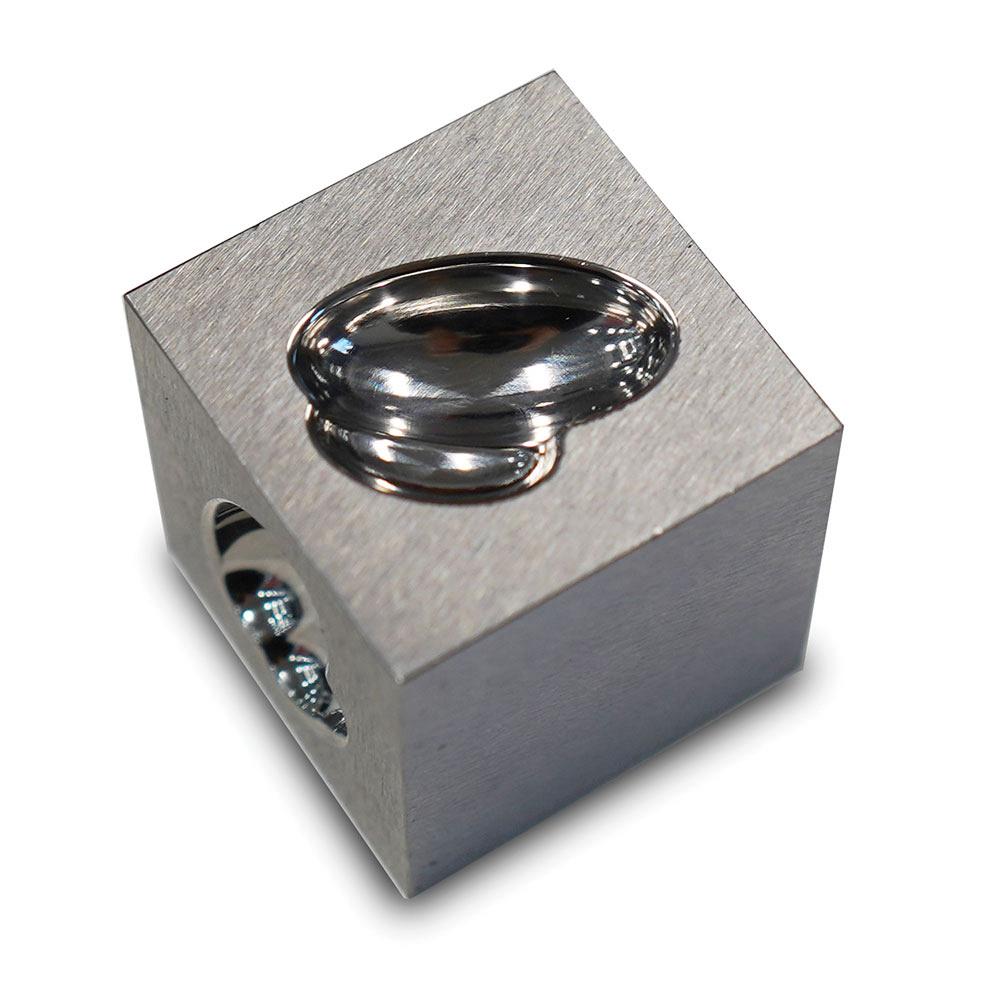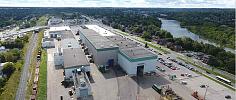Associate Editor
- FMA
- The Fabricator
- FABTECH
- Canadian Metalworking
Enhance surface finish with high-speed machining
HSM reduces chip load, heat generation, and vibration for better surface finish
- By Lindsay Luminoso
- April 29, 2024
- Article
- Metalworking

With HSM, there is a balancing act of the parameters involving the tool capabilities, machine capabilities, workholding conditions, toolholding options, and part material to ensure high-quality surface finish.GF Machining Solutions
As a concept, high-speed machining (HSM) was conceived by Dr. Carl J. Salomon during a series of experiments he undertook in 1924. Fast forward 100 years, and high-speed machining is not just a theoretical concept but one that, if done correctly, can provide exceptional surface finish and increased productivity.
What exactly is HSM? A general misconception is that high-speed machining and high-performance machining (HPM) are the same. But they are not the same. HPM provides a high chip removal rate, using trochoidal toolpaths with long tool engagement. However, HSM uses specific techniques and factors in a number of different aspects.
HSM emphasizes high speeds and feeds to increase productivity and improve surface quality. It requires a higher spindle RPM, uses smaller tools, and makes lighter cuts than traditional milling operations. It often is associated with a spindle speed above 15,000 RPM. But that’s not all that goes into HSM.
“With HSM, there is a balancing act of the parameters involving the tool capabilities, machine capabilities, workholding conditions, toolholding options, and part material,” said Christian Meekma, milling project manager, GF Machining Solutions, Lincolnshire, Ill. “When it comes to the milling world, there is no perfect formula, it’s all about understanding how various aspects influence the process and then adapting to that. And that is especially true when it comes to ensuring a good surface finish.”
Overall, HSM can achieve a smooth, uniform surface finish by managing chip load, heat generation, and vibration.
Reduced Chip Load
“With HSM, it enables a reduced depth of cut and uses faster speeds and feeds,” said William Gillcrist, national product and applications manager - machining division, MC Machinery Systems, Elk Grove Village, Ill. “Because you are able to go faster, you get better material removal rates even though you are taking smaller passes. This can result in the elimination of a semi-finish pass. HSM allows you to save time, better utilize the machine, and get the part closer to the net shape with the roughing pass.”
When working with HSM, you must consider the feed rate, especially as it relates to chip load. A larger feed per tooth will leave a rough surface finish compared to a smaller feed per tooth, which will result in a smooth surface finish. However, feeding too slow may cause burnishing, leaving a poor surface finish.
Running at a higher RPM means that the chip load is reduced, and the chips that are produced tend to be smaller, resulting in a smoother surface finish.
Reduced Heat Generation
When you think of machining at high speeds, you might immediately think high heat. But that is not the case. Though it may sound counterintuitive, it is possible to run at a high surface speed, heat generation often can be overcome. This is mainly because the cutting tool spends less time engaged with the workpiece.
“One of the primary advantages of HSM is heat dissipation,” said Meekma. “Using conventional techniques of cutting metal, heat is developed by forcing the cutting tool through it. When you go faster, by increasing the surface speed or RPM, you will get a certain peak before the temperature falls. The heat never really gets a chance to develop into the workpiece and is dissipated by the chip much better.”

HSM allows you to save time, better utilize the machine, and get the part closer to the net shape with the roughing pass. This part, made out of Polmax with a hardness of 52 HRC, has an Ra 0.018-µm mirror finish on a 3D surface. MC Machinery Systems
There is a balance that needs be struck, especially because the tool engagement during HSM is reduced compared to conventional techniques, but generally speaking, if you can get past that peak heat threshold, you can anticipate reduced heat.
“This is not true in all materials,” said Meekma. “For example, aluminum doesn’t act the same way as hardened steel. Obviously, the material will then dictate what you can actually do, and ultimately there is only so fast you can go on certain things, and that will affect surface finish.”
The goal of the process is to get the heat and chips away from the part as quickly as possible. Chip shape and colour are good indicators of a successful operation.
When machining hardened steels, chips that are blue or purple indicate that the heat is reaching the chip away from the part.
“HSM requires the right combination of a number of factors,” said Gillcrist. “The sharper the cutting tool, the better. A sharper cutting tool will get that shearing action, moving the chip away from the cutting zone to remove the heat. But that’s not always the case. For example, machining carbide, a sharp tool will not work, so it really does depend on the application.”
Reduced Vibration
One of the factors that determines HSM’s effectiveness is the machine itself. Today’s machine tools designed specifically for HSM often are extremely robust.
“It wasn’t until the 90s that the machine design really started to change,” said Meekma. “Conventional machines often used a boxway system, but with the rise of HSM, linear guideways were introduced to enable faster feeding and to perform HSM.”
Working with HSM means that the machine should have a strong frame to withstand the high forces and vibration generated. Choosing a machine with a polymer granite base, for example, provides significant absorption of vibration as well.
Vibration in any capacity hampers the ability to achieve high-quality surface finish. For example, when the cutting tool vibrates, it can leave marks on the workpiece, which may require additional passes to reach the desired finish.
“Cutting tool and workpiece stability all play a role,” said Gillcrist. “You should use a well-balanced tool with limited runout. Also, a rigid spindle with a quality toolholder will limit chatter. If you have a thin holder with the tool sticking way out and run it at a high RPM, it’s going to deflect and reduce surface finish quality.”

The HSM process needs to be well though out, especially when working with hard materials like this medical mold insert made out of H13 steel with 52 HRC. MC Machinery Systems
Ensuring that all aspects of the setup make sense for HSM applications will help eliminate vibration.
Additional Considerations for Improved Surface Finish
Effective HSM depends on a number of different elements and features. Any one aspect of the process can be a limiting factor to success.
“Spindle speed, feed rates, stepovers, step downs, cutting tool geometry, toolholder, runout, tool length-to-diameter ratio will all come into play, and this is especially true when HSM hard materials,” said Gillcrist. “The process itself needs to be well thought out.”
Stepover, a term to describe how far the tool moves over between each pass, also plays a big role in surface finish quality and productivity. One of the advantages of HSM is the time savings it takes to produce a part. However, if the stepover is too big, there will be a cusp between the toolpath that becomes visible. To get that visibly shiny surface, lighter cuts and smaller stepovers are required, and this can be effectively achieved through high spindle speeds.
For example, when roughing a 3D shape, there can be big steps, known as stair-stepping, in the part geometry. When working with HSM, the depth of cut can be reduced and the speed increased, meaning that you are taking smaller passes, leading to less visible stepovers.
“If you were to take a tool and run it at a very low speed, no matter what the feed rate or stepover, you won’t achieve as good of a finish like you would if you turn up the spindle and go really fast,” said Meekma. “The reason you don't do that in most scenarios is because the tool won't be able to handle the surface feed under the same conditions. But with all proper parameters dialed into HSM, you can. The faster RPM you get, the shinier the material will appear after cutting.”
Additionally, cutting tool attributes will play a role in surface finish. A quality cutting tool will be able to perform at high spindle speeds while the cutting edge cuts uniformly on the surface. This is also dependant on a good, rigid spindle that can hold the tool concentrically to the workpiece.
“When you take away any of one of those individual elements, that's where the surface finish starts to degrade,” said Meekma.
Associate Editor Lindsay Luminoso can be reached at lluminoso@fmamfg.org.
GF Machining Solutions, www.gfms.com
MC Machinery Systems, www.mcmachinery.com
About the Author

Lindsay Luminoso
1154 Warden Avenue
Toronto, M1R 0A1 Canada
Lindsay Luminoso, associate editor, contributes to both Canadian Metalworking and Canadian Fabricating & Welding. She worked as an associate editor/web editor, at Canadian Metalworking from 2014-2016 and was most recently an associate editor at Design Engineering.
Luminoso has a bachelor of arts from Carleton University, a bachelor of education from Ottawa University, and a graduate certificate in book, magazine, and digital publishing from Centennial College.
Related Companies
subscribe now


Keep up to date with the latest news, events, and technology for all things metal from our pair of monthly magazines written specifically for Canadian manufacturers!
Start Your Free Subscription- Industry Events
MME Saskatoon
- May 28, 2024
- Saskatoon, SK Canada
CME's Health & Safety Symposium for Manufacturers
- May 29, 2024
- Mississauga, ON Canada
DiPaolo Machine Tools Open House 2024
- June 4 - 5, 2024
- Mississauga, ON Canada
FABTECH Canada
- June 11 - 13, 2024
- Toronto, ON Canada
Zoller Open House & Technology Days 2024
- June 12 - 13, 2024
- Ann Arbor, MI




















